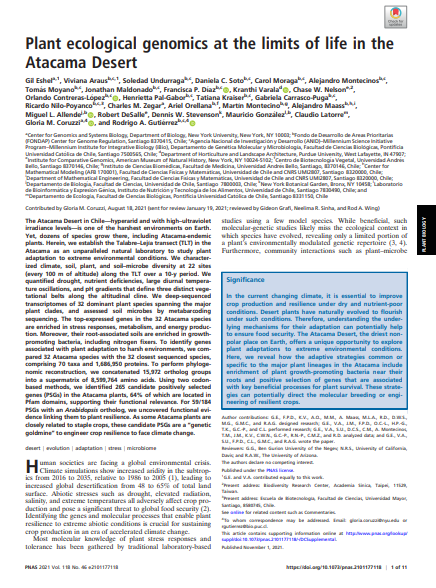Plant ecological genomics at the limits of life in the Atacama Desert

Fecha
2021-11-16Autor
Eshel, Gil
Araus, Viviana
Undurraga, Soledad
Soto, Daniela C.
Moraga, Carol
Montecinos, Alejandro
Moyano, Tomas C.
Maldonado, Jonathan
Díaz, Francisca P.
Varala, Kranthi
Nelson, Chase W.
Contreras-López, Orlando
Pal-Gabor, Henrietta
Kraiser, Tatiana
Carrasco-Puga, Gabriela
Nilo-Poyanco, Ricardo [Univ Mayor, Fac Ciencias, Escuela Biotecnol, Chile]
Zegar, Charles M.
Orellana, Ariel
Montecino, Martin
Maass, Alejandro
Allende, Miguel L.
DeSalle, Robert
Stevenson, Dennis W.
González, Mauricio
Latorre, Claudio
Coruzzi, Gloria M.
Gutiérrez, Rodrigo A.
Ubicación geográfica
Notas
HERRAMIENTAS
Acceda a títulos restringidos
¿Cómo descargar?Resumen
The Atacama Desert in Chile-hyperarid and with high-ultraviolet irradiance levels-is one of the harshest environments on Earth. Yet, dozens of species grow there, including Atacama-endemic plants. Herein, we establish the Talabre-Leji = a transect (TLT) in the Atacama as an unparalleled natural laboratory to study plant adaptation to extreme environmental conditions. We characterized climate, soil, plant, and soil-microbe diversity at 22 sites (every 100 m of altitude) along the TLT over a 10-y period. We quantified drought, nutrient deficiencies, large diurnal temperature oscillations, and pH gradients that define three distinct vegetational belts along the altitudinal cline. We deep-sequenced transcriptomes of 32 dominant plant species spanning the major plant clades, and assessed soil microbes by metabarcoding sequencing. The top-expressed genes in the 32 Atacama species are enriched in stress responses, metabolism, and energy production. Moreover, their root-associated soils are enriched in growthpromoting bacteria, including nitrogen fixers. To identify genes associated with plant adaptation to harsh environments, we compared 32 Atacama species with the 32 closest sequenced species, comprising 70 taxa and 1,686,950 proteins. To perform phylogenomic reconstruction, we concatenated 15,972 ortholog groups into a supermatrix of 8,599,764 amino acids. Using two codonbased methods, we identified 265 candidate positively selected genes (PSGs) in the Atacama plants, 64% of which are located in Pfam domains, supporting their functional relevance. For 59/184 PSGs with an Arabidopsis ortholog, we uncovered functional evidence linking them to plant resilience. As some Atacama plants are closely related to staple crops, these candidate PSGs are a "genetic goldmine" to engineer crop resilience to face climate change.
URI
https://repositorio.umayor.cl/xmlui/handle/sibum/9178https://www.ncbi.nlm.nih.gov/pmc/articles/PMC8609638/pdf/pnas.202101177.pdf
https://doi.org/10.1073/pnas.2101177118
https://doi.org/10.1073/pnas.2101177118
https://www.pnas.org/doi/epdf/10.1073/pnas.2101177118
Coleccion/es a la/s que pertenece:
Si usted es autor(a) de este documento y NO desea que su publicación tenga acceso público en este repositorio, por favor complete el formulario aquí.